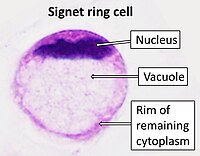
Photo from wikipedia
Bladder cancer is a very common cancer of the urinary system and the ninth most common type of cancer worldwide. Bladder cancers are categorized as urothelial and nonurothelial histologic types.… Click to show full abstract
Bladder cancer is a very common cancer of the urinary system and the ninth most common type of cancer worldwide. Bladder cancers are categorized as urothelial and nonurothelial histologic types. Urothelial carcinoma (transitional-cell carcinoma) is the predominant variety with an incidence of around 90–95%. Non-urothelial histology is further subdivided as epithelial and nonepithelial. Those of epithelial origin are adenocarcinoma, squamous cell carcinoma, and small cell tumors [1]. Nonepithelial cancers are very rare and include sarcomas, paragangliomas, melanomas, and lymphomas. Squamous cell carcinoma and adenocarcinoma represent only 3 and 2% of the primary bladder cancer cases, respectively. The most common age-group affected by adenocarcinoma is around 50–60 years. Patients with bladder exstrophy or persistent remnant urachus are at a higher risk of developing vesical adenocarcinoma. Chronic inflammation of the bladder mucosa induces metaplasia to the more protective squamous cell or glandular-type epithelium. Bladder adenocarcinoma is resistant to chemotherapy and radiation, so surgery is currently considered the most effective treatment option [3]. Thus, early diagnosis is crucial. Mucinous subtype of primary bladder adenocarcinoma (PBA) is extremely rare. Progressive change from mucinous metaplasia to mucinous adenoma to mucinous adenocarcinoma has been suggested as pathogenesis [2]. Diagnostic investigations are urinary cytology, cystoscopy, and biopsy followed by histopathological evaluation. To differentiate primary bladder adenocarcinoma from secondary type, immunohistochemistry might be helpful. Due to the unique etiopathogenesis and clinical course, management, and prognosis when compared to urothelial cancers and the relative lack of clinical reports, we herein report the case of a patient with primary mucinous adenocarcinoma of the bladder to help elucidate the characteristics of this tumor.
Journal Title: Indian Journal of Surgical Oncology
Year Published: 2019
Link to full text (if available)
Share on Social Media: Sign Up to like & get
recommendations!